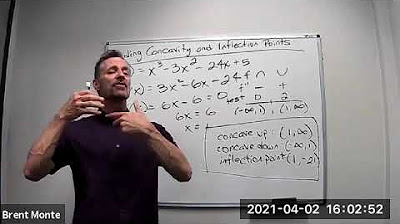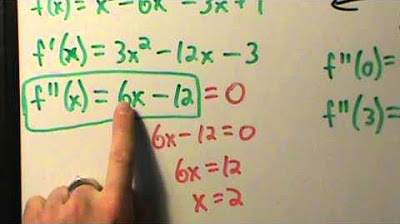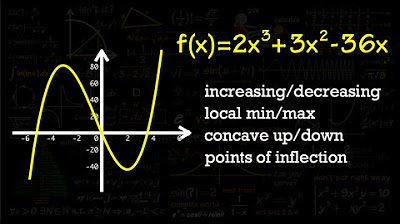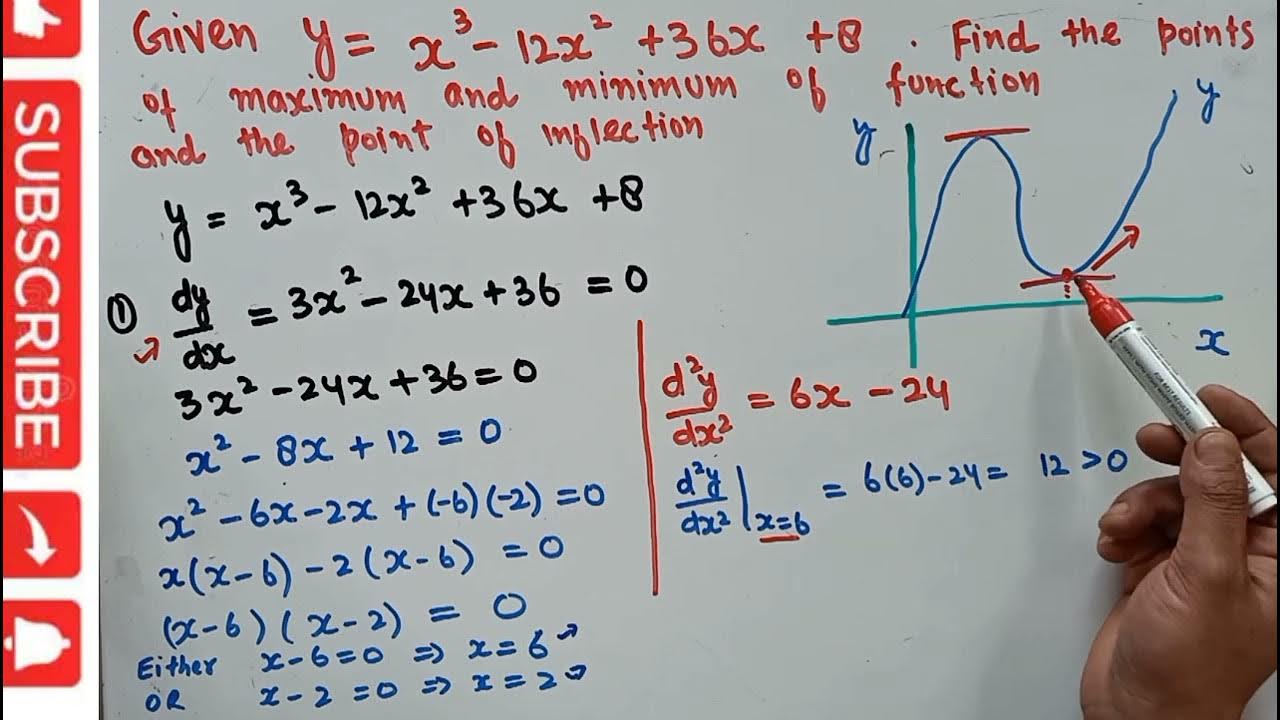Calculus I: Finding Intervals of Concavity and Inflection point
TLDRThe video script discusses the use of calculus to determine the concavity and inflection points of the function f(x) = 2x^3 - 3x^2. The process involves finding the first and second derivatives of the function. The first derivative is found to be 6x^2 - 6x, and the second derivative is 12x - 6. By setting the second derivative to zero, a potential inflection point at x = 1/2 is identified. The function's concavity is then tested by plugging in values from intervals around the potential inflection point. It is determined that the function is concave upward for x > 1/2 and concave downward for x < 1/2. The inflection point is confirmed at (1/2, -1/2) after evaluating the function at x = 1/2. This comprehensive approach to using calculus to analyze the function's behavior is both educational and engaging for viewers interested in mathematical analysis.
Takeaways
- 📚 The task involves analyzing a mathematical function using calculus to determine concavity and inflection points.
- 🔍 The given function is 2x^3 - 3x^2.
- 📉 Concavity is related to the second derivative of a function.
- 📚 The first derivative of the function is 6x^2 - 6x.
- 📈 The second derivative, crucial for concavity, is 12x - 6.
- 🔍 Setting the second derivative to zero gives 12x - 6 = 0, which simplifies to x = 1/2.
- 📝 An interval test is conducted using the second derivative to determine concavity.
- 📉 The function is concave upward on (1/2, ∞) and concave downward on (-∞, 1/2).
- 📍 The inflection point is where the concavity changes, which occurs at x = 1/2.
- 📌 The inflection point's coordinates are found by evaluating the function at x = 1/2, resulting in the point (1/2, -1/2).
Q & A
What is the given function in the transcript?
-The given function is 2x^3 - 3x^2.
What does concavity in calculus represent?
-Concavity represents the curvature of a function, indicating whether the function bends upward (concave up) or downward (concave down).
How is concavity related to derivatives?
-Concavity is related to the second derivative of a function. If the second derivative is positive, the function is concave up, and if it's negative, the function is concave down.
What is the first derivative of the given function?
-The first derivative of the function 2x^3 - 3x^2 is 6x^2 - 6x.
What is the second derivative of the given function?
-The second derivative of the function is 12x - 6.
How do you find the inflection point(s) of a function?
-To find the inflection point(s), you set the second derivative equal to zero and solve for x. Then you check the intervals around the critical points to determine where the concavity changes.
What is the x-coordinate of the possible inflection point found in the transcript?
-The x-coordinate of the possible inflection point is 1/2.
How did the transcript determine the intervals of concavity?
-The transcript determined the intervals of concavity by plugging in test points from intervals around the critical point (x = 1/2) into the second derivative and observing the sign changes.
What are the intervals on which the given function is concave up or concave down?
-The function is concave up on the interval (1/2, ∞) and concave down on the interval (-∞, 1/2).
What is the inflection point of the function?
-The inflection point of the function is at x = 1/2, with the corresponding y-coordinate being -1/2 after evaluating the function at x = 1/2.
Why is it important to evaluate the function at the inflection point?
-Evaluating the function at the inflection point gives you the exact coordinates of the point where the concavity changes, which is necessary for a complete description of the function's behavior.
Why is the function considered an even function in the transcript?
-The function is considered even because it is symmetric about the y-axis, which can be inferred from the absence of an x term with an odd exponent in the polynomial.
Outlines
📚 Calculus Application: Finding Concavity and Inflection Points
The script introduces a mathematical problem involving a function, 2x^3 - 3x^2, and aims to determine its concavity and inflection points using calculus. It emphasizes that graphing is not sufficient and instead requires finding derivatives. The first derivative of the function is calculated as 6x^2 - 6x, and the second derivative is found to be 12x - 6. The second derivative is set to zero to find potential inflection points, resulting in x = 1/2. An interval test is conducted by plugging in test points into the second derivative to determine the concavity on either side of x = 1/2. The function is found to be concave upward on the interval (1/2, ∞) and concave downward on the interval (-∞, 1/2). The inflection point is identified at x = 1/2, and the corresponding y-coordinate is calculated by substituting x = 1/2 back into the original function, yielding the point (1/2, -1/2).
Mindmap
Keywords
💡Concavity
💡Inflection Point
💡Derivative
💡Second Derivative
💡Interval Test
💡Polynomial Function
💡Function Evaluation
💡Graphing
💡Calculus
💡Rate of Change
💡Even Function
Highlights
The function to consider is 2x^3 - 3x^2.
The task is to find intervals of concavity and inflection points using calculus.
Concavity is related to the second derivative of the function.
The first derivative of the function is 6x^2 - 6x.
The second derivative is 12x - 6.
Setting the second derivative to zero gives x = 1/2 as a potential inflection point.
Interval testing is performed by considering the polynomial's behavior across intervals.
The function is defined for all real numbers from negative infinity to positive infinity.
The second derivative is tested at x = 0 and x = 1 to determine concavity.
When the second derivative is negative, the function is concave downward.
When the second derivative is positive, the function is concave upward.
The function is concave upward on the interval (1/2, positive infinity).
The function is concave downward on the interval (negative infinity, 1/2).
The inflection point occurs where concavity changes, identified at x = 1/2.
The inflection point's coordinates are found by evaluating the function at x = 1/2.
The inflection point is (1/2, -1/2).
Transcripts
Browse More Related Video
5.0 / 5 (0 votes)
Thanks for rating:





